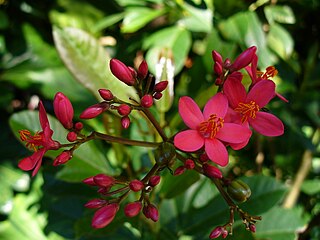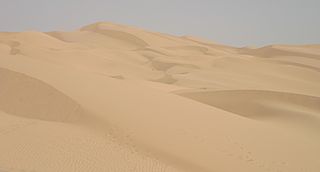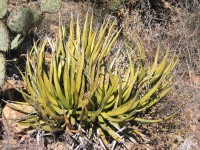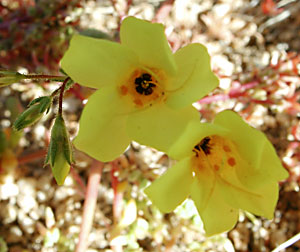
The Sonoran Desert is a North American desert and ecoregion which covers large parts of the Southwestern United States in Arizona and California and of Northwestern Mexico in Sonora, Baja California, and Baja California Sur. It is the hottest desert in Mexico. It has an area of 260,000 square kilometers (100,000 sq mi). The western portion of the United States–Mexico border passes through the Sonoran Desert.

Fouquieria splendens is a plant indigenous to the Sonoran Desert and Chihuahuan Desert in the Southwestern United States, and northern Mexico.

Jatropha is a genus of flowering plants in the spurge family, Euphorbiaceae. The name is derived from the Greek words ἰατρός (iatros), meaning "physician", and τροφή (trophe), meaning "nutrition", hence the common name physic nut. Another common name is nettlespurge. It contains approximately 170 species of succulent plants, shrubs and trees. Most of these are native to the Americas, with 66 species found in the Old World. Plants produce separate male and female flowers. As with many members of the family Euphorbiaceae, Jatropha contains compounds that are highly toxic. Jatropha species have traditionally been used in basketmaking, tanning and dye production. In the 2000s, one species, Jatropha curcas, generated interest as an oil crop for biodiesel production and also medicinal importance when used as lamp oil; native Mexicans in the Veracruz area developed by selective breeding a Jatropha curcas variant lacking the toxic compounds, yielding a better income when used as source for Biodiesel, because of its edible byproduct. Toxicity may return if edible Jatropha is pollinated by toxic types.

The Yuma Desert is a lower-elevation section of the Sonoran Desert in the southwestern United States and the northwest of Mexico. It lies in the Salton basin. The desert contains areas of sparse vegetation and has notable areas of sand dunes. With an average rainfall less than 8 inches (200 mm) each year, this is among the harshest deserts in North America. Human presence is sparse throughout, the largest city being Yuma, Arizona, on the Colorado River and the border of California.

Cnidoscolus is a plant genus of the family Euphorbiaceae first described as a genus in 1827. The group is widespread across much of North and South America, including the West Indies.

Manihot is a genus in the diverse milkspurge family, Euphorbiaceae. It was described as a genus in 1754.

The Sierra de la Laguna dry forests are a subtropical dry forest ecoregion of the southern Baja California Peninsula in Mexico.

Living Desert Zoo and Gardens, formerly the Living Desert Museum, is a desert botanical garden and a zoo located in Palm Desert, Riverside County, California, United States. They are in the Sonoran Desert of the Coachella Valley and Santa Rosa Mountains foothills near Palm Springs, California.

The Lechuguilla Desert is a small desert located in southwestern Arizona near the U.S.-Mexico border. It is considered to be part of the Lower Colorado Valley region of the Sonoran Desert. It lies in a north–south direction between the Gila Mountains and the Cabeza Prieta Mountains, and almost entirely in the Barry M. Goldwater Air Force Range. The desert is named after the Lechuguilla plant, known scientifically as Agave lecheguilla which according to the Wikipedia entry for that occurs exclusively in the Chihuahuan desert many hundreds of miles to the east. The desert is also on the north border of the Gran Desierto de Altar of Sonora, Mexico.

Cnidoscolus aconitifolius, commonly known as chaya or tree spinach, is a large, fast-growing leafy perennial shrub that is believed to have originated in the Yucatán Peninsula of Mexico. The specific epithet, aconitifolius, means "Aconitum-like leaves". It has succulent stems which exude a milky sap when cut. It can grow to be 6 metres (20 ft) tall, but is usually pruned to about 2 metres (6.6 ft) for easier leaf harvest. It is a popular leaf vegetable in Mexican and Central American cuisines, similar to spinach. The leaves should be cooked before being eaten, as the raw leaves contain a high content of toxic hydrocyanic acid. Up to 5 raw leaves can be eaten a day. To be safely eaten, the required cooking time is 5–15 minutes.

The Lower Colorado River Valley (LCRV) is the river region of the lower Colorado River of the southwestern United States in North America that rises in the Rocky Mountains and has its outlet at the Colorado River Delta in the northern Gulf of California in northwestern Mexico, between the states of Baja California and Sonora. This north–south stretch of the Colorado River forms the border between the U.S. states of California/Arizona and Nevada/Arizona, and between the Mexican states of Baja California/Sonora.
Mala mujer is a common name for several herbaceous plants in the genus Cnidoscolus with stinging hairs and may refer to:

Leptosiphon aureus is a species of flowering plant in the phlox family known by the common name golden linanthus.

Populus fremontii, commonly known as Frémont's cottonwood, is a cottonwood native to riparian zones of the Southwestern United States and northern through central Mexico. It is one of three species in Populus sect. Aigeiros. The tree was named after 19th century American explorer and pathfinder John C. Frémont.

The West Silver Bell Mountains are a small 10 mile (16 km) long mountain range of south-central Arizona, United States. The range lies in the north-central arid Sonoran Desert; the Madrean Sky Islands region of southeast Arizona, around Tucson is adjacent to the southeast.

Cnidoscolus urens is a perennial, tropical American stinging herb of the family Euphorbiaceae, and is one of some 100 species belonging to the genus Cnidoscolus. The plant is locally known as 'bull nettle', 'spurge nettle', 'bringamosa' and 'mala mujer'.
Guardiola platyphylla, the Apache plant, is a North American species of plants in the sunflower family, native to Mexico and the southwestern United States. It is found in northwestern Mexico and the southwestern United States.
Lucretia Breazeale Hamilton (1908-1986) was an American botanical illustrator, who was considered an expert on southwestern United States flora. She illustrated numerous technical papers for the University of Arizona and 16 books. She was posthumously recognized with a Desert Willow cultivar named in her honor and induction into the Arizona Women's Hall of Fame.















